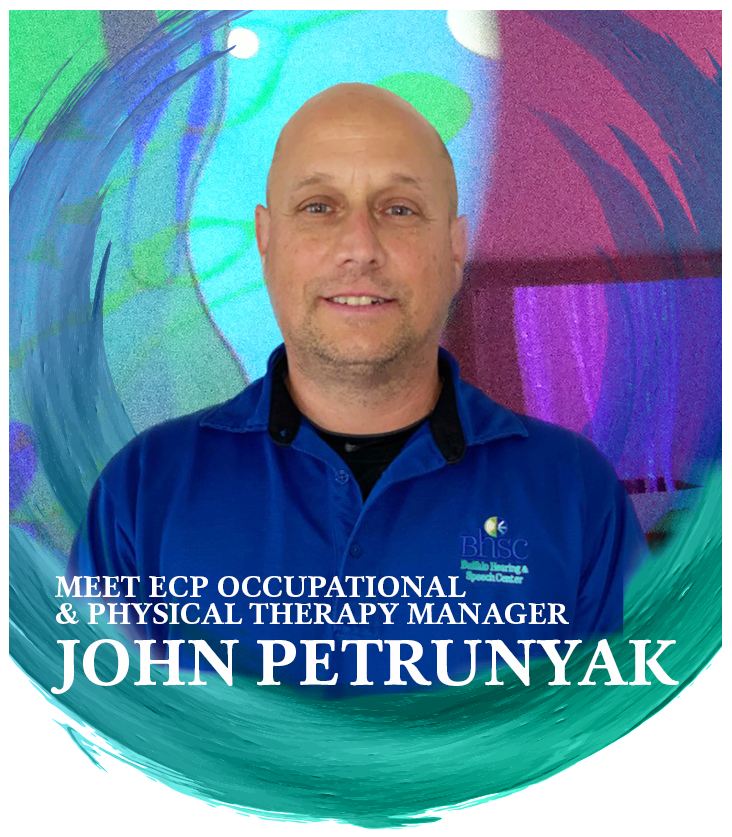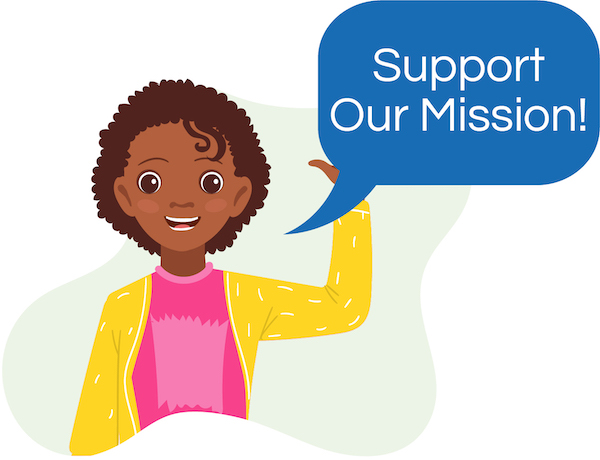Since BHSC is full of wonderful staff that are making differences in the lives of those we see every day, we thought it would be fun if you got to know us better! Let’s learn about John with his Fast Four about working at BHSC as a Physical Therapist and how he has adapted to teletherapy during the COVID-19 Epidemic.
John Petrunyak is a physical therapist and has worked at BHSC for 12 years. He is the Early Childhood Program Occupational and Physical Therapy Manager. John provides individual physical therapy services for our children by improving their strength, balance, coordination and gross motor skills.
What is your favorite memory at BHSC?
I have had many wonderful memories at Buffalo Hearing & Speech Center. It is hard to just pick one. I enjoy working day to day with a tremendous and passionate staff of Occupational and Physical Therapists and watching all of the successes of them engaging with their students. I smile each time when a child verbalizes “Hi Mr. John!”, looks at me and smiles, or gives me a high-five or fist bump. However, one of my favorite memories is when we finally opened The Buffalo Hearing & Speech Center sensory room at our North Street location. This room helps teach children with autism and other behavioral or sensory challenges to regulate their bodies to achieve success in the classroom. We have seen that time spent in the sensory room helps students improve their visual, auditory and tactile processing as well as their fine and gross motor skills. By using vestibular or proprioceptive movement, the sensory room can provide a sense of calm and comfort to help our children learn to self-regulate their behaviors, ultimately improving their focus. Improved focus and information processing can make a significant impact on their ability not only to learn but in how they engage with their teachers and peers.
How do you hope to grow in your position at BHSC or how have you grown?
When I first started twelve years ago with BHSC, I was a guy who had two kids of his own but had very little experience working with children who had developmental delays. I have learned so much from all of the wonderful staff throughout the years and continue to do so each and every day.
What advice would you give to young people who want to enter into your field?
The very first thing that I can say to a person entering this field is to be adaptable and willing to change. As we have seen this year change is fluid. Many of us could have never imagined that teletherapy would ever be part of our vocabulary and now it is part of something we talk about and do every day. I would also say that a physical therapist’s job or any therapist’s job (OT, Speech, etc.) can be action packed and sometimes physically demanding. There is also a lot of paperwork involved. Therefore, anyone entering this field should know that maintaining one’s own health is very important. I like to do this through coaching baseball, playing golf and enjoying time with friends and family.
Describe to us how Telehealth physical therapy works?
Teletherapy, also known as telehealth, involves therapists providing care virtually over a secure technology platform to a client that is not in the same location. The process is similar to a FaceTime call, except it is through a secure HIPAA compliant app (i.e. Zoom). If you have a computer, a microphone and a camera (which most computers/laptops/IPads/smartphones have automatically now) and a strong internet connection you are all set.
Buffalo Hearing & Speech Center physical therapy practitioners have become an integral part of teletherapy. They began providing virtual care for both our school based and preschool students back in March when the COVID-19 pandemic began sweeping the United States. They use teletherapy to deliver many of the same treatments they would have used for in-person treatments. Some of these interventions include hands-on activities (of course not their hands now but the child’s caregiver’s hands), exercises, interactive games, and evaluating children who have difficulty with strength, balance, bilateral coordination, postural control, endurance, playing or engaging in gross motor activities, and managing emotions or behaviors.
Through a secure platform, the child can interact with the therapist just as he/she would if it was an in person session. For our students, a parent or caregiver is on the end with the student, providing cueing and any “hands-on” techniques that may be needed. In a teletherapy session, the caregiver takes a more active role in the therapy session. For example: Prior to a session the therapist may send the family a short “lesson plan” and list of items/toys suggested for the session. Once the session begins the therapist may demonstrate a new activity or technique and coach the parent through achieving the session’s objective. The therapist may share their screen, play games, share handouts, resources and other activities throughout the session to target each child’s therapy goals. At the end of the session, the therapist usually discusses how to continue the session activities throughout the week, any concerns the parent may have and schedule the next session. Teletherapy sessions are usually 30 minutes in length.
Although there are certain advantages to therapy services in school, the recent need for teletherapy has also highlighted some advantages to this type of service delivery. During teletherapy, the children are seen in the environment in which they spend most of their time, their home. The therapists are able to help the children develop skills and routines in their homes using materials, toys, etc that the student routinely has available. Since parents are encouraged to participate in teletherapy sessions, the interaction with their child’s therapist allows them to learn ways they can further support their child’s progress and can then quickly carry over the skills into their home routines. Although teletherapy was not how we envisioned providing physical therapy services this year, in this time of crisis and unpredictability it has been uplifting to continue to see our students progress, stay connected and continue to learn and be engaged during the COVID-19 pandemic.
October is National Physical Therapy Month (NPTM) National Physical Therapy Month started in 1981 and has grown over the past 30 years. The goal of NPTM is to raise awareness about the importance of physical therapy in helping people find relief from pain, improve mobility and live healthier lives. Each year, the American Physical Therapy Association (APTA) chooses a theme for the month. In the past, a few themes have been regarding posture, balance, low back pain, obesity, and sports injury prevention. However, this year I would like the time to say thank you! Thank you to the Buffalo Hearing & Speech Center’s Early Childhood Program’s Physical Therapists (PTs) and Physical Therapist Assistants (PTAS) for all you do to keep our children moving! Jessica Bickett, Brianna Cuthbert, Meredith Lewis, Samantha Brennan, Julie Taylor, Taylor Tilley, Scott Swanson, Kristin Scobey, and Julie Bugaj, you are heroes every day for your children with developmental delays. You change, support, enrich, and improve their lives in so many ways including their social, emotional and educational development. That is why words are not enough to show how very grateful I am for your support, help and hard work within the physical therapy department. You have a very special gift and way with the children that you work with. You are so appreciated in all that you do.




